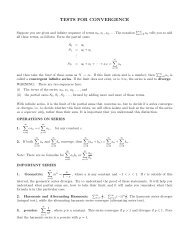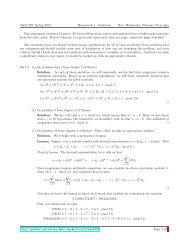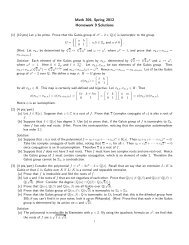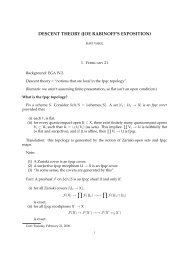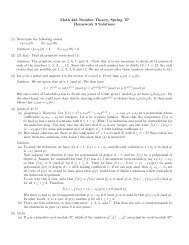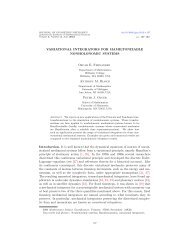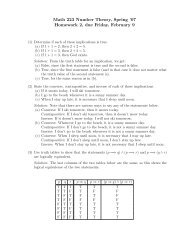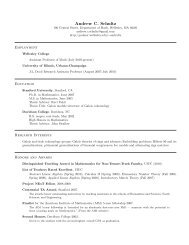Math 306, Spring 2012 Second Midterm Exam Solutions
Math 306, Spring 2012 Second Midterm Exam Solutions
Math 306, Spring 2012 Second Midterm Exam Solutions
- No tags were found...
You also want an ePaper? Increase the reach of your titles
YUMPU automatically turns print PDFs into web optimized ePapers that Google loves.
<strong>Math</strong> <strong>306</strong>, <strong>Spring</strong> <strong>2012</strong><strong>Second</strong> <strong>Midterm</strong> <strong>Exam</strong> <strong>Solutions</strong>Name:Student ID:Directions: Check that your test has 8 pages, including this one and the blank one on the bottom(which you can use as scratch paper or to continue writing out a solution if you run out room elsewhere).Please show all your work. Write neatly: solutions deemed illegible will not be graded, so nocredit will be given. This exam is closed book, closed notes. You have 70 minutes. Good luck!1. (16 points)2. (15 points)3. (7 points)4. (9 points)5. (12 points)6. (9 points)Total (out of 68):Curved score (out of 100):Letter grade:
1. (2 pts each) Give examples of the following.(a) An angle that cannot be trisected.Solution: π/3(b) A splitting field of x 4 + 4 ∈ Q[x].Solution: Q(i) (We have the factorization x 4 + 4 = (x 2 + 2x + 2)(x 2 − 2x + 2), where the factors areirreducible by Eisenstein’s criterion (using p = 2). The roots are ±1, ±i, so the splitting field is Q(i).)(c) An irreducible cubic polynomial f ∈ Q[x] such that [L: Q] = 6, where L is the splitting field of f.Solution: x 3 − 2(d) A nonnormal extension.Solution: Q( 3√ 2): Q(e) An inseparable extension.Solution: Z 2 ( √ u): Z 2 (u)(f) A nontrivial Q-automorphism σ : Q( √ 2, √ 3) → Q( √ 2, √ 3).Solution: σ determined by √ 2 ↦→ − √ 2 and √ 3 ↦→ √ 3.(g) An extension L: K such that Gal(L/K) ∼ = Z 2 × Z 2 .Solution: Q( √ 2, √ 3): Q(h) An extension L: K such that Gal(L/K) ∼ = Z 3 .Solution: Q( 3√ 2, e 2πi/3 ): Q(e 2πi/3 )2
2. (a) (10 pts) Prove that, if L is the splitting field of some f ∈ K[x], then the extension L: K is normal. (Thisis one direction of Theorem 5.)Solution: This is Theorem 9.9 on page 111 which you were asked to read. Here are the details:Let L be the splitting field of g. Then L: K is finite. Let f be irreducible in K[x] with a zero in L. Let M ⊇ Lbe a splitting field for fg in K[x] with a zero in L. Suppose θ 1 and θ 2 are zeros of f in M. For j = 1, 2, wehave[L(θ 1 ): L][L: K] = [L(θ 1 ): K(θ 1 )][K(θ 1 ): K]and[L(θ 2 ): L][L: K] = [L(θ 2 ): K(θ 2 )][K(θ 2 ): K].Now [K(θ 1 ): K] = [K(θ 2 ): K] because θ 1 and θ 1 have the same minimum polynomial over K. Also[L(θ 1 ): K(θ 1 )] = [L(θ 2 ): K(θ 2 )] since L(θ 1 ) → L(θ 2 ) is an isomorphism of splitting fields extending K(θ 1 ) →K(θ 2 ). Therefore [L(θ 1 ): L] = [L(θ 2 ): L].(b) (5 pts) Prove that, if L is algebraic over K and every element of L belongs to an intermediate field that isnormal over K, then L is normal over K.Solution: Let L: K be algebraic. Suppose f ∈ K[x] is irreducible with root α ∈ L. Then α belongs to someintermediate field M, where M : K is normal, so all roots of f lie in M. Therefore all roots of f lie in L.Therefore L: K is normal.3
3. (7 pts) Let p be prime and let b ∈ Z p be fixed. If α is a root of the polynomial f = x p − x + b ∈ Z p [x], provethat Z p (α) is a normal extension of Z p . (Hint: You may use without proof that, for all c ∈ Z p , c p = c.)Solution: (Note: This is very similar to a homework problem.) Suppose that α is a root of f, i.e. we haveα p − α + b = 0. Then for all c ∈ Z p we have (α + c) p − (α + c) + b = α p + c p − α − c + b = c p − c. But, by thehint, for all c ∈ Z p we have c p = c, and thus α + c is a root of f for all c ∈ Z p . Therefore, we have identified proots of f. Since f has at most p roots, these are exactly the roots of f. Hence Z(α) is the splitting field forf and Z p (α) is hence normal (by Theorem 5).4
4. (a) (4 pts) State a lemma relating the degrees of K(α, β), K(α), and K(β) over K if the degrees of theminimal polynomials of α and β are relatively prime.Solution: [K(α, β) : K] = [K(α) : K][K(β) : K](b) (5 pts) Use part (a) to show that the degree of the splitting field of x p − 2 ∈ Q[x], p prime, is p(p − 1).Solution: See class notes.5
5. (a) (5 pts) Let ζ = e 2πi/5 . Prove that Q(ζ) is a normal extension of Q and determine with proof the Galoisgroup Gal(Q(ζ)/Q). (Hint: It suffices to verify the order of one particular element in the Galois group.)Solution: (Note: <strong>Second</strong> part was a homework problem.) We know that Q(ζ) is the splitting field of x 5 − 1 ∈Q[x], so the extension is normal. We claim that the Galois group is Z 4 . The minimum polynomial of ζ over Qis f = x 4 + x 3 + x 2 + x + 1, and the four roots are ζ, ζ 2 , ζ 3 and ζ 4 . Let σ 2 be the automorphism determinedby ζ ↦→ ζ 2 . Then σ 2 has order 4 in the Galois group, so the Galois group must be Z 4 .(b) (7 pts) Let n ∈ Z ≥3 be fixed and let ζ = e 2πi/n . Prove that Gal(Q(ζ)/Q) is abelian.Solution: (Note: This was a review problem.) Let σ, ρ ∈ Gal(L/Q). Then σ and ρ are determined bye 2πi/n ↦→ e 2πij/n and e 2πi/n ↦→ e 2πik/n ,respectively. This is because each root of unity has to go to another root of unity. I.e. suppose σ(ζ) = c. Then,since σ fixes Q, we have1 = σ(1) = σ(ζ n ) = σ(ζ) n = c n ,and so c = n√ 1. Same for ρ. In addition, it suffices to specify each automorphism on just ζ since where allother roots of unity are sent is determined by this (as they are all powers of ζ).Thenσ(ρ(e 2πi/n )) = σ(e 2πik/n ) = e 2πijk/n and ρ(σ(e 2πi/n )) = σ(e 2πij/n ) = e 2πijk/n .Since all elements of Gal(L/Q) are determined by e 2πi/n , it follows that σ ◦ ρ = ρ ◦ σ for all automorphisms σand ρ, so Gal(L/Q) is abelian.6
6. (a) (4 pts) State the Galois Correspondence. Be sure to define the maps ∗ and †.Solution: See class notes.(a) (5 pts) Show by example that maps ∗ and † need not be inverses of each other in general.Solution: See class notes.7



